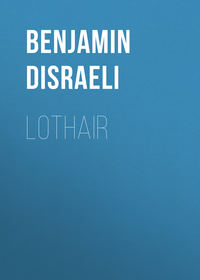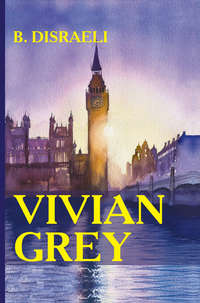 полная версия
полная версияAlroy: The Prince of the Captivity
‘He is modest,’ replied Honain, rather alarmed; ‘and is frightened at the liberty he has taken.’
‘I like modesty,’ said the Princess; ‘it is interesting. I am modest; you think so?’
‘Certainly,’ said Honain.
‘And interesting?’
‘Very.’
‘I detest an interesting person. After all, there is nothing like plain dulness.’
‘Nothing,’ said Honain.
‘The day flows on so serenely in such society.’
‘It does,’ said Honain.
‘No confusion; no scenes.’
‘None.’
‘I make it a rule only to have ugly slaves.’
‘You are quite right.’
‘Honain, will you ever contradict me? You know very well I have the handsomest slaves in the world.’
‘Every one knows it.’
‘And, do you know, I have taken a great fancy to your new purchase, who, according to your account, is eminently qualified for the post. Why, do you not agree with me?’
‘Why, yes; I doubt not your Highness would find him eminently qualified, and certainly few things would give me greater pleasure than offering him for your acceptance; but I got into such disgrace by that late affair of the Circassian, that–’
‘Oh! leave it to me,’ said the Princess.
‘Certainly,’ said the physician, turning the conversation; ‘and when the young King of Karasmé arrives at Bagdad, you can offer him to his majesty as a present.’
‘Delightful! and the king is really handsome and young as well as brave; but has he any taste?’
‘You have enough for both.’
‘If he would but make war against the Greeks!’
‘Why so violent against the poor Greeks?’
‘You know they are Giaours. Besides, they might beat him, and then I should have the pleasure of being taken prisoner.’
‘Delightful!’
‘Charming! to see Constantinople, and marry the Emperor.’
‘Marry the Emperor!’
‘To be sure. Of course he would fall in love with me.’
‘Of course.’
‘And then, and then, I might conquer Paris!’
‘Paris!’
‘You have been at Paris?’34
‘Yes.’
‘The men are shut up there,’ said the Princess with a smile, ‘are they not? and the women do what they like?’
‘You will always do what you like,’ said Honain, rising.
‘You are going?’
‘My visits must not be too long.’
‘Farewell, dear Honain!’ said the Princess, with a melancholy air. ‘You are the only person who has an idea in all Bagdad, and you leave me. A miserable lot is mine, to feel everything, and be nothing. These books and flowers, these sweet birds, and this fair gazelle: ah! poets may feign as they please, but how cheerfully would I resign all these elegant consolations of a captive life for one hour of freedom! I wrote some verses on myself yesterday; take them, and get them blazoned for me by the finest scribe in the city; letters of silver on a violet ground with a fine flowing border; I leave the design to you. Adieu! Come hither, mute.’ Alroy advanced to her beckon, and knelt. ‘There, take that rosary for thy master’s sake, and those dark eyes of thine.’
The companions withdrew, and reached their boat in silence. It was sunset. The musical and sonorous voice of the Muezzin resounded from the innumerable minarets of the splendid city. Honain threw back the curtains of the barque. Bagdad rose before them in huge masses of sumptuous dwellings, seated amid groves and gardens. An infinite population, summoned by the invigorating twilight, poured forth in all directions. The glowing river was covered with sparkling caiques, the glittering terraces with showy groups. Splendour, and power, and luxury, and beauty were arrayed before them in their most captivating forms, and the heart of Alroy responded to their magnificence. ‘A glorious vision!’ said the Prince of the Captivity.
‘Very different from Hamadan,’ said the physician of the Caliph.
‘To-day I have seen wonders,’ said Alroy.
‘The world is opening to you,’ said Honain.
Alroy did not reply; but after some minutes he said, in a hesitating voice, ‘Who was that lady?’
‘The Princess Schirene,’ replied Honain, ‘the favourite daughter of the Caliph. Her mother was a Georgian and a Giaour.’
The moonlight fell upon the figure of Alroy lying on a couch; his face was hidden by his arm. He was motionless, but did not sleep.
He rose and paced the chamber with agitated steps; sometimes he stopped, and gazed on the pavement, fixed in abstraction. He advanced to the window, and cooled his feverish brow in the midnight air.
An hour passed away, and the young Prince of the Captivity remained fixed in the same position. Suddenly he turned to a tripod of porphyry, and, seizing a rosary of jewels, pressed it to his lips.
‘The Spirit of my dreams, she comes at last; the form for which I have sighed and wept; the form which rose upon my radiant vision when I shut my eyes against the jarring shadows of this gloomy world.
‘Schirene! Schirene! here in this solitude I pour to thee the passion long stored up: the passion of my life, no common life, a life full of deep feeling and creative thought. O beautiful! O more than beautiful! for thou to me art as a dream unbroken: why art thou not mine? why lose a moment in our glorious lives, and balk our destiny of half its bliss?
‘Fool, fool, hast thou forgotten? The rapture of a prisoner in his cell, whose wild fancy for a moment belies his fetters! The daughter of the Caliph and a Jew!
‘Give me my fathers’ sceptre.
‘A plague on talismans! Oh! I need no inspiration but her memory, no magic but her name. By heavens! I will enter this glorious city a conqueror, or die.
‘Why, what is Life? for meditation mingles ever with my passion: why, what is Life? Throw accidents to the dogs, and tear off the painted mask of false society! Here am I a hero; with a mind that can devise all things, and a heart of superhuman daring, with youth, with vigour, with a glorious lineage, with a form that has made full many a lovely maiden of our tribe droop her fair head by Hamadan’s sweet fount, and I am—nothing!
‘Out on Society! ‘twas not made for me. I’ll form my own, and be the deity I sometimes feel.
‘We make our fortunes, and we call them Fate. Thou saidst well, Honain. Most subtle Sadducee! The saintly blood flowed in my fathers’ veins, and they did nothing; but I have an arm formed to wield a sceptre, and I will win one.
‘I cannot doubt my triumph. Triumph is a part of my existence. I am born for glory, as a tree is born to bear its fruit, or to expand its flowers. The deed is done. ‘Tis thought of, and ‘tis done. I will confront the greatest of my diademed ancestors, and in his tomb. Mighty Solomon! he wedded Pharaoh’s daughter. Hah! what a future dawns upon my hope. An omen, a choice omen!
‘Heaven and earth are mingling to form my fortunes. My mournful youth, which I have so often cursed, I hail thee: thou wert a glorious preparation; and when feeling no sympathy with the life around me, I deemed myself a fool, I find that I was a most peculiar being. By heavens, I am joyful; for the first time in my life I am joyful. I could laugh, and fight, and drink. I am new-born; I am another being; I am mad!
‘O Time, great Time! the world belies thy fame. It calls thee swift. Methinks thou art wondrous slow. Fly on, great Time, and on thy coming wings bear me my sceptre!
‘All is to be. It is a lowering thought. My fancy, like a bright and wearied bird, will sometimes flag and fall, and then I am lost. The young King of Karasmé, a youthful hero! Would he had been Alschiroch! My heart is sick even at the very name. Alas! my trials have not yet begun. Jabaster warned me: good, sincere Jabaster! His talisman presses on my frantic heart, and seems to warn me. I am in danger. Braggart to stand here, filling the careless air with idle words, while all is unaccomplished. I grow dull. The young King of Karasmé! Why, what am I compared to this same prince? Nothing, but in my thoughts. In the full bazaar, they would not deem me worthy even to hold his stirrup or his slipper– Oh! this contest, this constant, bitter, never-ending contest between my fortune and my fancy! Why do I exist? or, if existing, why am I not recognised as I would be?
‘Sweet voice, that in Jabaster’s distant cave de-scendedst from thy holy home above, and whispered consolation, breathe again! Again breathe thy still summons to my lonely ear, and chase away the thoughts that hover round me; thoughts dark and doubtful, like fell birds of prey hovering around a hero in expectation of his fall, and gloating on their triumph over the brave. There is something fatal in these crowded cities. Faith flourishes in solitude.’
He threw himself upon the couch, and, leaning down his head, seemed lost in meditation. He started up, and, seizing his tablets, wrote upon them these words:
‘Honain, I have been the whole night like David in the wilderness of Ziph; but, by the aid of the Lord, I have conquered. I fly from this dangerous city upon his business, which I have too much neglected. Attempt not to discover me, and accept my gratitude.’
CHAPTER VI
The Learned Rabbi ZimriA SCORCHING sun, a blue and burning sky, on every side lofty ranges of black and barren mountains, dark ravines, deep caverns, unfathomable gorges! A solitary being moved in the distance. Faint and toiling, a pilgrim slowly clambered up the steep and stony track.
The sultry hours moved on; the pilgrim at length gained the summit of the mountain, a small and rugged table-land, strewn with huge masses of loose and heated, rock. All around was desolation: no spring, no herbage; the bird and the insect were alike mute. Still it was the summit: no loftier peaks frowned in the distance; the pilgrim stopped, and breathed with more facility, and a faint smile played over his languid and solemn countenance.
He rested a few minutes; he took from his wallet some locusts and wild honey, and a small skin of water. His meal was short as well as simple. An ardent desire to reach his place of destination before nightfall urged him to proceed. He soon passed over the table-land, and commenced the descent of the mountain. A straggling olive-tree occasionally appeared, and then a group, and soon the groups swelled into a grove. His way wound through the grateful and unaccustomed shade. He emerged from the grove, and found that he had proceeded down more than half the side of the mountain. It ended precipitously in a dark and narrow ravine, formed on the other side by an opposite mountain, the lofty steep of which was crested by a city gently rising on a gradual slope.
Nothing could be conceived more barren, wild, and terrible than the surrounding scenery, unillumined by a single trace of culture. The city stood like the last gladiator in an amphitheatre of desolation.
It was surrounded by a lofty turreted wall, of an architecture to which the pilgrim was unaccustomed: gates with drawbridge and portcullis, square towers, and loopholes for the archer. Sentinels, clothed in steel and shining in the sunset, paced, at regular intervals, the cautious wall, and on a lofty tower a standard waved, a snowy standard, with a red, red cross!
The Prince of the Captivity at length beheld the lost capital of his fathers.35
A few months back, and such a spectacle would have called forth all the latent passion of Alroy; but time and suffering, and sharp experience, had already somewhat curbed the fiery spirit of the Hebrew Prince. He gazed upon Jerusalem, he beheld the City of David garrisoned by the puissant warriors of Christendom, and threatened by the innumerable armies of the Crescent. The two great divisions of the world seemed contending for a prize, which he, a lonely wanderer, had crossed the desert to rescue.
If his faith restrained him from doubting the possibility of his enterprise, he was at least deeply conscious that the world was a very different existence from what he had fancied amid the gardens of Hamadan and the rocks of Caucasus, and that if his purpose could be accomplished, it could only be effected by one means. Calm, perhaps somewhat depressed, but full of pious humiliation, and not deserted by holy hope, he descended into the Valley of Jehoshaphat, and so, slaking his thirst at Siloah, and mounting the opposite height, David Alroy entered Jerusalem by the gate of Zion.36
He had been instructed that the quarter allotted to his people was near this entrance. He inquired the direction of the sentinel, who did not condescend to answer him. An old man, in shabby robes, who was passing, beckoned to him.
‘What want you, friend?’ inquired Alroy.
‘You were asking for the quarter of our people. You must be à stranger, indeed, in Jerusalem, to suppose that a Frank would speak to a Jew. You were lucky to get neither kicked nor cursed.’
‘Kicked and cursed! Why, these dogs–’
‘Hush! hush! for the love of God,’ said his new companion, much alarmed. ‘Have you lent money to their captain that you speak thus? In Jerusalem our people speak only in a whisper.’
‘No matter: the cure is not by words. Where is our quarter?’
‘Was the like ever seen! Why, he speaks as if he were a Frank. I save him from having his head broken by a gauntlet, and–’
‘My friend, I am tired. Our quarter?’
‘Whom may you want?’
‘The Chief Rabbi.’
‘You bear letters to him?’
‘What is that to you?’
‘Hush! hush! You do not know what Jerusalem is, young man. You must not think of going on in this way. Where do you come from?’
‘Bagdad.’
‘Bagdad! Jerusalem is not Bagdad. A Turk is a brute, but a Christian is a demon.’
‘But our quarter, our quarter?’
‘Hush! you want the Chief Rabbi?’
‘Ay! ay!’
‘Rabbi Zimri?’
‘It may be so. I neither know nor care.’
‘Neither knows nor cares! This will never do; you must not go on in this way at Jerusalem. You must not think of it.’
‘Fellow, I see thou art a miserable prattler. Show me our quarter, and I will pay thee well, or be off.’
‘Be off! Art thou a Hebrew? to say “be off” to any one. You come from Bagdad! I tell you what, go back to Bagdad. You will never do for Jerusalem.’
‘Your grizzled beard protects you. Old fool, I am a pilgrim just arrived, wearied beyond expression, and you keep me here listening to your flat talk!’
‘Flat talk! Why! what would you?’
‘Lead me to the Rabbi Zimri, if that be his name.’
‘If that be his name! Why, every one knows Rabbi Zimri, the Chief Rabbi of Jerusalem, the successor of Aaron. We have our temple yet, say what they like. A very learned doctor is Rabbi Zimri.’
‘Wretched driveller. I am ashamed to lose my patience with such a dotard.’
‘Driveller! dotard! Why, who are you?’
‘One you cannot comprehend. Without another word, lead me to your chief.’
‘Chief! you have not far to go. I know no one of the nation who holds his head higher than I do here, and they call me Zimri.’
‘What, the Chief Rabbi, that very learned doctor?’
‘No less; I thought you had heard of him.’
‘Let us forget the past, good Zimri. When great men play the incognito, they must sometimes hear rough phrases. It is the Caliph’s lot as well as yours. I am glad to make the acquaintance of so great a doctor. Though young, and roughly habited, I have seen the world a little, and may offer next Sabbath in the synagogue more dirhems than you would perhaps suppose. Good and learned Zimri, I would be your guest.’
‘A very worshipful young man! And he speaks low and soft now! But it was lucky I was at hand. Good, what’s your name?’
‘David.’
‘A very honest name, good David. It was lucky I was at hand when you spoke to the sentinel, though. A Jew speak to a Frank, and a sentinel too! Hah! hah! hah! that is good. How Rabbi Maimon will laugh! Faith it was very lucky, now, was not it?’
‘Indeed, most fortunate.’
‘Well that is candid! Here! this way. ‘Tis not far. We number few, sir, of our brethren here, but a better time will come, a better time will come.’
‘I think so. This is your door?’
‘An humble one. Jerusalem is not Bagdad, but you are welcome.’
‘King Pirgandicus37 entered them,’ said Rabbi Maimon, ‘but no one since.’
‘And when did he live?’ inquired Alroy. ‘His reign is recorded in the Talmud,’ answered Rabbi Zimri, ‘but in the Talmud there are no dates.’ ‘A long while ago?’ asked Alroy. ‘Since the Captivity,’ answered Rabbi Maimon. ‘I doubt that,’ said Rabbi Zimri, ‘or why should he be called king?’
‘Was he of the house of David?’ said Alroy.
‘Without doubt,’ said Rabbi Maimon; ‘he was one of our greatest kings, and conquered Julius Caesar.‘38
‘His kingdom was in the northernmost parts of Africa,’ said Rabbi Zimri, ‘and exists to this day, if we could but find it.’
‘Ay, truly,’ added Rabbi Maimon, ‘the sceptre has never departed out of Judah; and he rode always upon a white elephant.’
‘Covered with cloth of gold,’ added Rabbi Zimri. ‘And he visited the Tombs of the Kings?’39 inquired Alroy.
‘Without doubt,’ said Rabbi Maimon. ‘The whole account is in the Talmud.’
‘And no one can now find them?’ ‘No one,’ replied Rabbi Zimri: ‘but, according to that learned doctor, Moses Hallevy, they are in a valley in the mountains of Lebanon, which was sealed up by the Archangel Michael.’
‘The illustrious Doctor Abarbanel, of Babylon,’ said Rabbi Maimon, ‘gives one hundred and twenty reasons in his commentary on the Gemara to prove that they sunk under the earth at the taking of the Temple.’
‘No one reasons like Abarbanel of Babylon,’ said Rabbi Zimri.
‘The great Rabbi Akiba, of Pundebita, has answered them all,’ said Rabbi Maimon, ‘and holds that they were taken up to heaven.’
‘And which is right?’ inquired Rabbi Zimri.
‘Neither,’ said Rabbi Maimon.
‘One hundred and twenty reasons are strong proof,’ said Rabbi Zimri.
‘The most learned and illustrious Doctor Aaron Mendola, of Granada,’ said Rabbi Maimon, ‘has shown that we must look for the Tombs of the Kings in the south of Spain.’
‘All that Mendola writes is worth attention,’ said Rabbi Zimri.
‘Rabbi Hillel,40 of Samaria, is worth two Mendolas any day,’ said Rabbi Maimon.
‘‘Tis a most learned doctor,’ said Rabbi Zimri; ‘and what thinks he?’
‘Hillel proves that there are two Tombs of the Kings,’ said Rabbi Maimon, ‘and that neither of them are the right ones.’
‘What a learned doctor!’ exclaimed Rabbi Zimri.
‘And very satisfactory,’ remarked Alroy.
‘These are high subjects,’ continued Maimon, his blear eyes twinkling with complacency. ‘Your guest, Rabbi Zimri, must read the treatise of the learned Shimei, of Damascus, on “Effecting Impossibilities.”’
‘That is a work!’ exclaimed Zimri.
‘I never slept for three nights after reading that work,’ said Rabbi Maimon. ‘It contains twelve thousand five hundred and thirty-seven quotations from the Pentateuch, and not a single original observation.’
‘There were giants in those days,’ said Rabbi Zimri; ‘we are children now.’
‘The first chapter makes equal sense, read backward or forward,’ continued Rabbi Maimon. ‘Ichabod!’ exclaimed Rabbi Zimri. ‘And the initial letter of every section is a cabalistical type of a king of Judah.’
‘The temple will yet be built,’ said Rabbi Zimri. ‘Ay, ay! that is learning!’ exclaimed Rabbi Maimon; ‘but what is the great treatise on “Effecting Impossibilities” to that profound, admirable, and–’
‘Holy Rabbi!’ said a youthful reader of the synagogue, who now entered, ‘the hour is at hand.’
‘You don’t say so! Learned Miamon, I must to the synagogue. I could sit here all day listening to you. Come, David, the people await us.’
Zimri and Alroy quitted the house, and proceeded along the narrow hilly streets to the chief temple of the Hebrews.
‘It grieves the venerable Maimon much that he cannot join us,’ said Rabbi Zimri. ‘You have doubtless heard of him at Bagdad; a most learned doctor.’ Alroy bowed in silence.
‘He bears his years well. You would hardly believe that he was my master.’
‘I perceive that you inherit much of his erudition.’
‘You are kind. If he have breathed one year, Rabbi Maimon will be a hundred and ten next Passover.’
‘I doubt it not.’
‘When he is gathered to his fathers, a great light will be extinguished in Israel. You wanted to know something about the Tombs of the Kings; I told you he was your man. How full he was! His mind, sir, is an egg.’
‘A somewhat ancient one. I fear his guidance will hardly bring me the enviable fortune of King Pirgandicus.’
‘Between ourselves, good David, talking of King Pirgandicus, I cannot help fancying that the learned Maimon made a slight mistake. I hold Pirgandicus was only a prince. It was after the Captivity, and I know no authority for any of our rulers since the destruction assuming a higher title. Clearly a prince, eh? But, though I would whisper it to no one but you, I think our worthy friend grows a little old. We should remember his years, sir. A hundred and ten next Passover. ‘Tis a great burden.’
‘Ay! with his learning added, a very fearful burden indeed!’
‘You have been a week in Jerusalem, and have not yet visited our synagogue. It is not of cedar and ivory, but it is still a temple. This way. It is only a week that you have been here? Why, you look another man! I shall never forget our first meeting: you did not know me. That was good, eh? And when I told you I was the chief Rabbi Zimri, how you changed! You have quite regained your appetite. Ah! ‘tis pleasant to mix once more with our own people. To the left. So! we must descend a little. We hold our meetings in an ancient cemetery. You have a finer temple, I warrant me, in Bagdad. Jerusalem is not Bagdad. But this has its conveniences. ‘Tis safe, and we are not very rich, nor wish to seem so.’
A long passage brought them to a number of small, square, low chambers41 leading into each other. They were lighted by brass lamps, placed at intervals in vacant niches, that once held corpses, and which were now soiled by the smoky flame. Between two and three hundred individuals were assembled in these chambers, at first scarcely distinguishable by those who descended from the broad daylight; but by degrees the eyesight became accustomed to the dim and vaporous atmosphere, and Al-roy recognised in the final and more illumined chamber a high cedar cabinet, the type of the ark, and which held the sacred vessels and the sanctified copy of the law.
Standing in lines, with their heads mystically covered,42 the forlorn remnant of Israel, captives in their ancient city, avowed, in spite of all their sufferings, their fidelity to their God, and, notwithstanding all the bitterness of hope delayed, their faith in the fulfilment of his promises. Their simple service was completed, their prayers were read, their responses made, their law exhibited, and their charitable offerings announced by their high priest. After the service, the venerable Zimri, opening a volume of the Talmud, and fortified by the opinions of all those illustrious and learned doctors, the heroes of his erudite conversations with the aged Maimon, expounded the law to the congregation of the people.43
‘It is written,’ said the Rabbi, ‘“Thou shalt have none other God but me.” Now know ye what our father Abraham said when Nimrod ordered him to worship fire? “Why not water,” answered Abraham, “which can put out fire? why not clouds, which can pour forth water? why not the winds, which can produce clouds? why not God, which can create winds?”’
A murmur of approbation sounded throughout the congregation.
‘Eliezer,’ said Zimri, addressing himself to a young Rabbi, ‘it is written, that he took a rib from Adam when he was asleep. Is God then a robber?’
The young Rabbi looked puzzled, and cast his eyes on the ground. The congregation was perplexed and a little alarmed.
‘Is there no answer?’ said Zimri.
‘Rabbi,’ said a stranger, a tall, swarthy African pilgrim, standing in a corner, and enveloped in a red mantle, over which a lamp threw a flickering light; ‘Rabbi, some robbers broke into my house last night, and stole an earthen pipkin, but they left a golden vase in its stead.’
‘It is well said; it is well said,’ exclaimed the congregation. The applause was loud.
‘Learned Zimri,’ continued the African, ‘it is written in the Gemara, that there was a youth in Jerusalem who fell in love with a beautiful damsel, and she scorned him. And the youth was so stricken with his passion that he could not speak; but when he beheld her, he looked at her imploringly, and she laughed. And one day the youth, not knowing what to do with himself, went out into the desert; and towards night he returned home, but the gates of the city were shut. And he went down into the valley of Jehoshaphat, and entered the tomb of Absalom and slept;44 and he dreamed a dream; and next morning he came into the city smiling. And the maiden met him, and she said, “Is that thou; art thou a laugher?” and he answered, “Behold, yesterday being disconsolate, I went out of the city into the desert, and I returned home, and the gates of the city were shut, and I went down into the valley of Jehoshaphat, and I entered the tomb of Absalom, and I slept, and I dreamed a dream, and ever since then I have laughed.” And the damsel said, “Tell me thy dream.” And he answered and said, “I may not tell my dream only to my wife, for it regards her honour.” And the maiden grew sad and curious, and said, “I am thy wife, tell me thy dream.” And straightway they went and were married and ever after they both laughed. Now, learned Zimri, what means this tale, an idle jest for a master of the law, yet it is written by the greatest doctor of the Captivity?’









